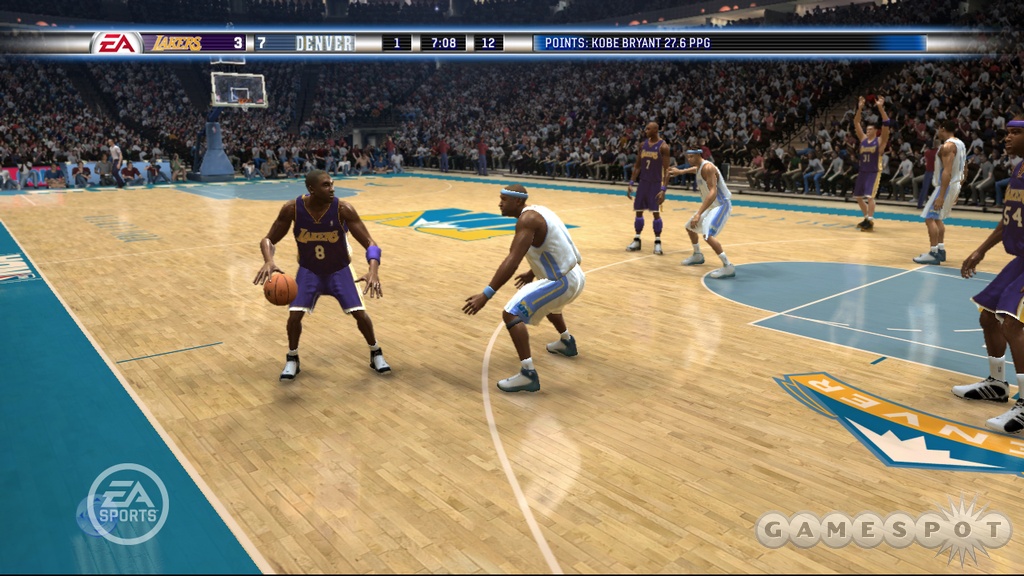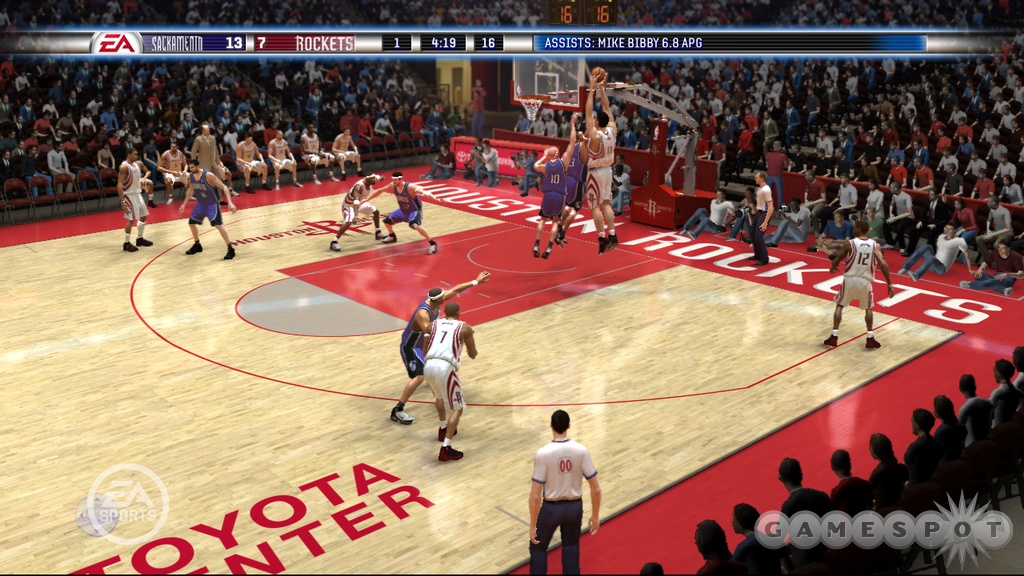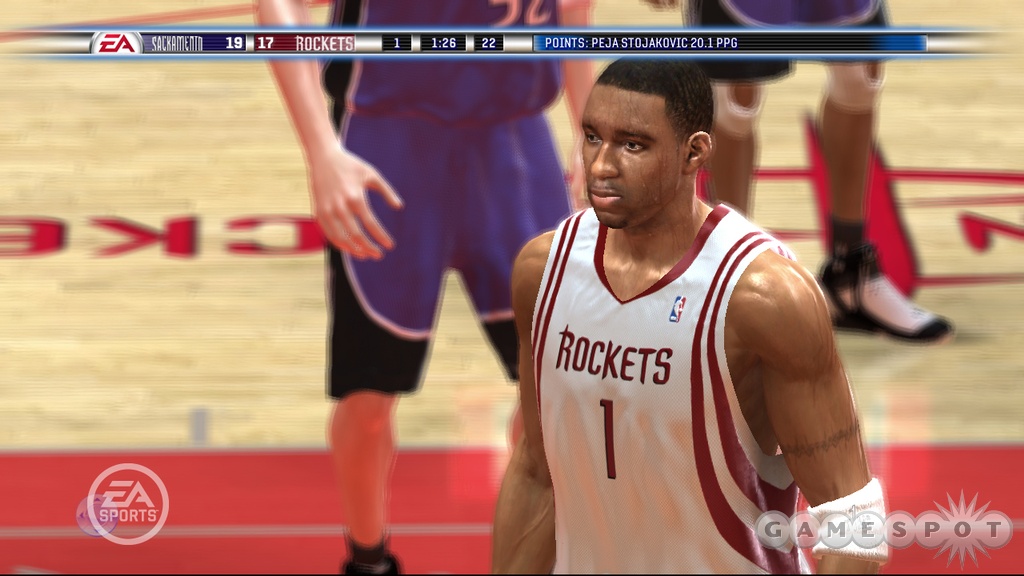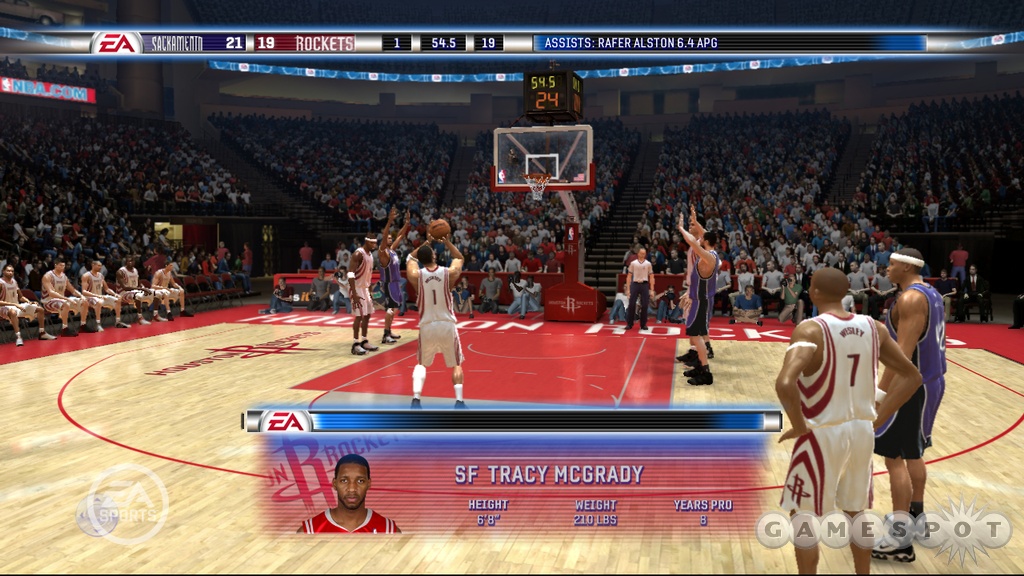NBA Live 06 Q&A
Producer Tim Tschirner gives us the lowdown on the low post… or at least the graphical know-how that went into creating it for NBA Live 06 for Xbox 360, in this exclusive Q&A.
The first thing that jumped out at us when we saw NBA Live 06 at E3 in May was the stunningly realistic player models. OK, that isn't entirely true--the first thing we actually noticed was the torrential amounts of sweat that was pouring down the bodies of those stunningly realistic player models. Still, it's obvious from the get-go that the team at EA Canada has spent a good amount of time refining the look of its signature basketball series, upgrading everything from crowd animations, to stadium details, and practically everything in between. To get an idea of just what went into this extensive graphical makeover, we spoke with NBA Live 06 producer Tim Tschirner.
GameSpot: When you set out on development for NBA Live 06 for the 360, what were some of the goals or milestones you felt the team had to reach from a graphical standpoint?

Tim Tschirner: From the beginning, our two main goals were authenticity and realism. In terms of authenticity, we wanted to see every player in the league represented at the highest level of detail, and we wanted them to play in arenas so accurate and rich with detail that you could actually find your season ticket seats. And we didn't want to stop at just accurate likeness in game characters. We literally wanted to build "humans who play NBA basketball" with all of the complexities of human appearance and behavior.
Since we wanted this game to be completely redesigned from the ground up specifically for the next-generation consoles, we didn't want to upgrade just a few star players and bring the rest forward from current gen. This would have created a disturbing visual continuity on the court. We left everything behind and built all-new next-gen players and environments.
GS:Unlike football stadiums and baseball parks, it's sometimes tough to notice the subtle differences in NBA arenas. How did the NBA Live 06 team approach building realistic arenas and how successful was that approach?
TT: It's true, the individual differences can seem subtle, but when you put them all together the spaces really feel different. That's something I think we really captured well in the game this year. We wanted to give you the feeling that when you play in a different arena you're really traveling to a new place and you're able to feel what it's like to be playing in that city's real arena. With all this authentic detail and realism, we designed our cameras to really take advantage and give you a complete picture of your surroundings.

To build all these realistic arenas we started by tossing out all the arenas from current gen. Even though they are all authentic, they simply didn't scale up anymore. We worked really close with the NBA to gather exhaustive reference shots from every arena. We literally spent months gathering tens of thousands of photographs of every inch of each arena. The photographers we worked with shot the images to detailed technical specifications so that we could use a process called photogrammetry to build the geometry. In this process, the images are analyzed by computer software that re-creates the objects in the scene to the exact dimensions of their real-life counterparts. Other reference images are then used for the surface textures. On top of all that, a team of very talented artists then puts the final finishing touches to each arena with a lot of attention to detail.
Because every aspect of these environments was captured from the actual locations that they represent, the result is unparalleled realism. These aren't artist renditions of NBA arenas; these are the real things.
The Realm of Possibility
GS: When developing a game's graphics, what kind of things are possible on the Xbox 360 that weren't possible before?
TT: There are really two parts to that. First there are the new things you can do with new hardware that is so much more powerful than anything before it, and then there are the new opportunities for a change in thinking that can come from a major console change such as this.

Branching off as a separate team to work exclusively on the Xbox 360 allowed us to rethink every facet of the game and how we approach making games. In deciding to rewrite it all, we took nothing as a given and designed a fresh game experience. When we started, we didn't know what the hardware could do yet, so we worked on our visual targets and started building the art based on what we wanted to see rather than what we knew we could do. This put the pressure on the technical side of things to achieve our goals, but in the end, we definitely exceeded our visual targets. With the ability now to exponentially increase our polygon count, use much more complex shaders, textures, lighting models, and physical simulations, the new hardware has freed us up to think more about what we want to do rather than just focusing on what we can do. It's really a developer's dream come true, since the Xbox 360 has given us a whole new canvas to paint on.
GS: Can you give us an idea of how many new animations have been added to the game for the Xbox 360? How will those new animations reflect in the actual gameplay on the court?
TT: I can't give you a concrete total number of animations, but compared to previous years there are four to five times the number of new animations in the Xbox 360 version of NBA Live 06. All of our player movements are new this year, as we spent a great deal of effort trying to eliminate all of the foot sliding that has been seen in past iterations of Live. We have a ton of new dunks and layups, including alley-oops and put-back dunks. They not only look amazing, but they also allowed us to further differentiate superstar dunkers from the rest of the league. With our reduced collision cylinders and rag-doll-like physics we have been able to create more advanced and organic collisions, not only while players move around, but also when they go up to dunk on a defender.
We have added in some signature jump shots as well to further highlight our focus on reality. To name a few, we have Wade's, KG's, Tony Parker's, and Shawn Marion shots in there, and they all show off the different shooting styles that the different NBA players have. Related to this, we have more than 40 signature free-throw routines, from Rip over Shaq to Jermaine O'Neal.
There are a bunch of new passes and receptions, which add more variety and enabled us to add more flow to the game, especially with our rewritten fast-break logic. Players will now receive the ball on the wings and continue on to the hoop with the new moving pass receptions instead of stopping and catching on the fast break. Some of these new receptions also square the receiver up, putting them in a good situation to catch and shoot. This works great when passing out of the post or off a penetration and kick to a player spotting up.
We've added in new content for rebounds as well to help highlight our improved rebounding logic this year. Players will now be able to rebound the ball in a better position to fire an outlet pass to start the fast break by turning to face up court as they are landing.
And finally, we have added a ton of animation into our crowd this year. Spectators stand and cheer or sit and boo, and they taunt visiting players when they are shooting free throws by waving their arms to distract them. They also stand and cheer for made three-point shots and rise to their feet in anticipation when a player is on a fast break. The new and improved crowd is a big component to the overall five-on-five atmosphere.
All in all, for the 360 version of Live we have added a ton of new animations that have allowed us to show off the amazing things that real NBA superstars can do.
Working on Hippy Hair
GS: We couldn't help but notice you got Steve Nash's hair moving for the 360 version of NBA Live 06. Talk us through the process of making his hippy haircut come to life. Did you ever think you'd spend that much time on a guy's hair?
TT: Well, we definitely didn't want to take our new highly detailed authentic players and just give them helmets for hair! We were well aware from the beginning that it would be dangerous to just try to upgrade parts of a game to a next-gen experience, because as some things improve, it makes the other parts look even worse, and so realistic-looking hair moving in a believable way was another must-have for us. Long hair like Nash's is a rarity in the NBA, but even with so few chances to see it, we were determined to make all the players look fantastic and authentic, not just some of them. It was definitely a lot of work for a few guys. His hair is made up of literally hundreds of grouped strands all driven by a physics simulation that reacts to his every movement. Because each particle in the simulation moves independently, the result is something quite complex and realistic.

GS: It won't be long before most players take things like realistic cloth physics for granted, but we suspect it's a pretty difficult thing to achieve in development. Can you tell us what went into making sure the shorts and jerseys move in conjunction with the players?
TT: Cloth has traditionally been a difficult problem even for prerendered feature film effects, and it's very exciting to me that we're even talking about this for games, let alone doing it. When we were poring over NBA footage last year in preparation for this game, it became clear to us that cloth is really a major visual feature in basketball. Nowadays, the uniforms have gotten so baggy that the traditional stiff approach of rigging the cloth to the player's skeleton just wasn't going to cut it in next gen. We prototyped a bunch of different solutions, but initially they created movement that was too random and rubbery and didn't have enough wrinkle detail for the look that we wanted. So again, we turned to our physics team for a solution, and together with the AI team they came up with a system that derives individual movement from the complex motion of the player in real time and then creates the realistic motion of the cloth. It even factors in the different materials to re-create realistic movement of NBA uniforms while allowing for the fine wrinkle detail you would get with real cloth.
GS: What's with all the perspiration? The last time we saw an NBA guy sweat this much it was Karl Malone in the 1997 Finals.
TT: The sweat was a cool feature that we unveiled at E3 and has since gotten a lot of exposure in the press. It all goes back to making these NBA players feel like real humans. We looked at a lot of references to come up with the look and intensity levels of the sweat implementation. When a game starts, the players are completely dry and the level of sweat builds up over the course of the game. Some players sweat more, some players sweat less. Toward the end of an intensive game most players are usually drenched in sweat, unless they've just been substituted in. That's how it is in real life, and that's how we implemented it in the final version of Live 06.
GS: Tell us about the camera angles in the game. How did you arrive at the new default camera angle and how do you think it benefits the action on the floor? What other camera options will players have at their disposal?
TT: Cameras are so important--all this amazing realistic detail just goes to waste if you can't see it properly. Also, if you're going for extreme realism and then you have a really "video-gamey" camera pointing at it, you'll never be able to elevate the experience. We spent a lot of effort on our cameras this year to give them a more realistic feel. The cameras have been given their own AI so that they can look like they are being operated by real human camera operators. In this game, our virtual camera operator knows where the ball has been, but doesn't know exactly where it's going--it can only guess. That creates a very realistic sense of operator error, where sometimes the camera will overshoot the action a bit and then correct, just like a real broadcast. We also wanted to get the cameras in closer to the action. They're generally a bit lower and framed closer so you can feel more of the intensity of the game.
Also, you will have a few different gameplay camera options to choose from, as well as the ability to customize height and zoom level for every camera individually.
GS: We know that this is only the beginning for the next-generation "look" of the Live series. Can you give us an idea of the kinds of things the team is interested in pursuing for the future iterations of the game? What areas of focus will make the game even more realistic looking in the future?
TT: This is indeed just the beginning--just the first year on next-generation hardware. We are really excited about what we were able to do in this first year and there are lots and lots of things we have on our wish list for future years. It's constantly evolving, but we know where we're headed. You'll understand that I can't go into specifics, but I can tell you that we've got some nice surprises in store for you.
GS: Thanks Tim, for your time.
Got a news tip or want to contact us directly? Email news@gamespot.com
Join the conversation